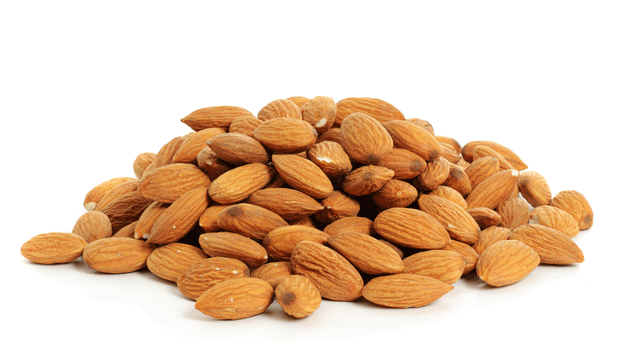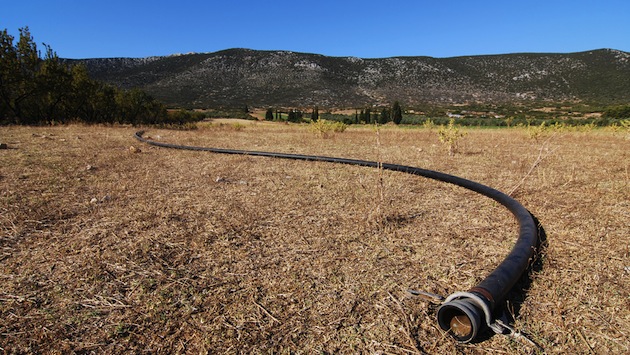
<a href="http://www.shutterstock.com/pic-129364064/stock-photo-heap-of-peeled-almond-nuts-isolated-on-white.html?src=Llb42ov0ag3zLZmBlFImmA-1-96" target="_blank">Roxana Bashyrova</a>/Shutterstock
California farmers will reap a record 2.1 billion pounds of almonds this year, the USDA estimates—about three times as much as they did in 2000. That’s great news for the world’s growing horde of almond eaters, because the state’s groves supply 80 percent of the global harvest. As this chart shows, California has been planting more and more almonds over the past two decades:
And those almonds are miniature cash cows:
But in the long term, the almond boom may prove bad news for everyone who relies on California’s farms for sustenance. You might have heard that the state, supplier of half of US-grown produce, is locked in its worst drought on record. Meanwhile, it takes 1.1 gallons of water to produce a single almond, as my colleagues Alex Park and Julia Lurie have shown. You don’t have to scramble to figure how many almonds make up 2.1 billion pounds to realize that that’s a hell of a lot of water.
Where does it all come from, when the drought has forced the state to slash its allotments of groundwater to farms? As I and others reported back in April, California farm country has been swept up in a drilling frenzy—farmers are dropping wells and drawing down the state’s aquifers at rates much faster than they can be replenished.
The water rush has only intensified as the dry, hot summer has settled in, NPR recently reported. Its story depicts drilling-company workers toiling 12-hour days, seven days per week, to keep up with demand for new wells.
Remarkably, new almond groves—and the wells needed to make them productive—keep coming. “Right where a brand new almond orchard will be planted, a drilling rig bores a hole in the earth 2,500 feet deep,” the NPR piece reports. “All told, this well will cost the farmer about $1 million.”
According to US Department of Agriculture figures, California’s almond crop has continued its relentless expansion right through the drought, which started in 2012 (see chart above).
Why would farmers be scrambling to drop wells to prop up a thirsty crop during an historic drought? Surging demand—both from Asia and in the United States—have kept almond prices high even as the state expands production. Between 2009 and 2013, almond prices doubled and even tripled, depending on variety.
Of course, not every farmer can afford to make the huge well investments required to churn out almonds in a drought. As this 2014 Oakland Institute report—which I wrote about here—shows, large financial firms are snapping up farmland, switching from row crops to almonds and other nuts, and dropping in wells, positioning themselves to cash in on Asia’s rising, almond-munching middle classes.
The ecological implications are potentially dire. In a huge swath of the almond-intensive San Joaquin Valley, the ground has literally been sinking by an average of 11 inches per year, a 2013 US Geological Survey study found. The culprit: over-pumping of aquifers. Such subsidence, as its known, threatens vital infrastructure like bridges, roads, and irrigation canals. In an interview last spring, one of the study’s authors, USGS scientist Michelle Sneed, told me that the ongoing switch from row crops like vegetables to nuts plays a role in subsidence. You can fallow fields of annual vegetables during droughts, but almond trees need a steady supply of water for years.
Meanwhile, groundwater depletion is also making the Sierra Nevada and Coast Mountain ranges slowly rise—enough to potentially trigger earthquakes, a 2014 Nature paper found. Then there’s the bee problem—growing 80 percent of the globe’s almonds in a few tightly packed swaths of California creates massive pest pressure and requires fully 60 percent of the nation’s managed honeybees for pollination. As beekeepers learned this spring, hauling in 1.6 million honeybee hives into an area dripping with insecticides is a recipe for disaster.
Looming over it all is the whole question of how long California farmers can continue the unchecked siphoning of water from the state’s aquifers. No one knows for sure—but there’s no doubt that something has to give. One prominent paleoclimatologist, the University of California-Berkeley’s B. Lynn Ingram, warns that California won’t likely return to 20th-century levels of rainfall anytime soon. That means reliance on pumping will likely harden with time. Researchers at the University of California Center for Hydrologic Modeling recently found that between the start of the drought in November 2011 and November 2013, the Sacramento and San Joaquin river basins lost 20 cubic kilometers of groundwater, a level it called “severe.” The researchers warned of “potentially dire consequences for the economic and food security of the United States.”
“We’re on a one-way trajectory toward depletion, toward running out of groundwater,” Jay Famiglietti, a University of California hydrologist, told NPR. “So it’s not unlike having several straws in a glass, and everyone drinking at the same time, and no one really watching the level.”














